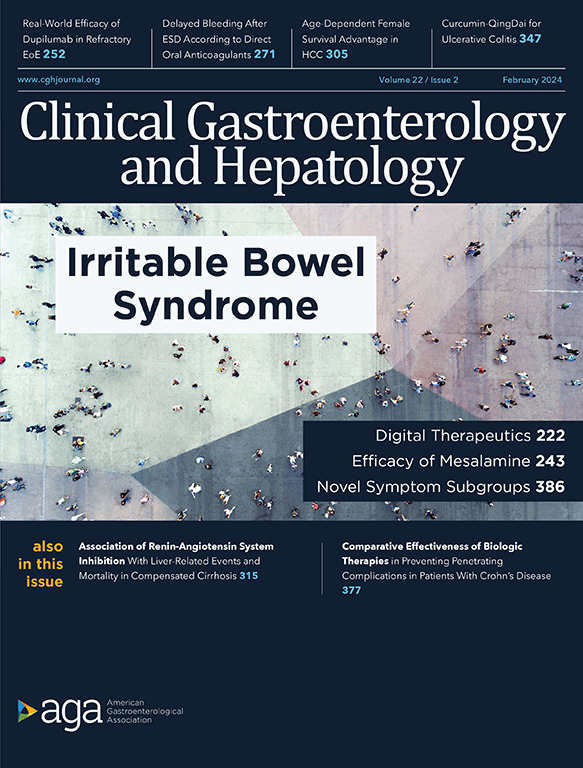感染后肠易激综合征结肠通透性增加的转录组和代谢组相关性。
IF 11.6
1区 医学
Q1 GASTROENTEROLOGY & HEPATOLOGY
引用次数: 0
摘要
背景和目的:感染后肠易激综合征(PI-IBS)在流行病学上是众所周知的,但其生理和分子特征却没有得到很好的研究。我们旨在确定 PI-IBS 的生理表型、结肠转录组、粪便微生物组和代谢组:方法:我们招募了 51 名罗马 III 型弯曲菌 PI-IBS 患者和 39 名健康志愿者(HV)。参与者完成了问卷调查、体内肠道渗透性、胃肠道转运和直肠感觉。收集粪便样本用于霰弹枪元基因组学和非靶向代谢组学研究,并收集乙状结肠活检样本用于批量 RNAseq 研究。确定了差异基因表达、微生物群组成差异和代谢物丰度。通过加权基因相关网络分析确定了基因和代谢物群,并确定了与临床和生理参数的相关性:PI-IBS(59% 女性,46±2 岁)和 HV(64% 女性,42±2 岁)的人口统计学特征相当。肠易激综合征症状严重程度平均分为 227 分;94% 的患者无便秘。PI-IBS患者2-24小时乳糖排泄量增加,表明结肠通透性增加(4.4±0.5 mg vs. 2.6±0.3 mg,p=0.01)。两组的结肠转运和感觉阈值相似。总体而言,2036 个粘膜基因和 223 种粪便代谢物的表达存在差异,女性的变化更为显著。PI-IBS患者粪便中的N-乙酰putrescine增加,与结肠通透性、腹泻恶化有关,并与Collinsella aerofaciens的数量呈负相关。组胺和 N-乙酰组胺与 2-24 小时乳糖排泄呈正相关。八个加权基因共表达模块与表型(性别、大便次数、结肠通透性、转运)显著相关:结论:弯曲杆菌 PI-IBS 患者的结肠通透性较高,这与多胺和组胺代谢物的变化有关。女性患者的分子变化更大。本文章由计算机程序翻译,如有差异,请以英文原文为准。
Transcriptomic and Metabolomic Correlates of Increased Colonic Permeability in Postinfection Irritable Bowel Syndrome
Background & Aims
Postinfection irritable bowel syndrome (PI-IBS) is well-known epidemiologically; however, its physiological and molecular characteristics are not well studied. We aimed to determine the physiological phenotypes, colonic transcriptome, fecal microbiome, and metabolome in PI-IBS.
Methods
Fifty-one Rome III Campylobacter PI-IBS patients and 39 healthy volunteers (HV) were enrolled. Participants completed questionnaires, in vivo intestinal permeability, gastrointestinal transit, and rectal sensation. Fecal samples were collected for shotgun metagenomics, untargeted metabolomics, and sigmoid colonic biopsies for bulk RNAseq. Differential gene expression, differences in microbiota composition, and metabolite abundance were determined. Gene and metabolite clusters were identified via weighted gene correlation network analysis and correlations with clinical and physiological parameters determined.
Results
PI-IBS (59% female; 46 ± 2 years) and HV (64% female; 42 ± 2 years) demographics were comparable. Mean IBS-symptom severity score was 227; 94% were nonconstipation. Two- to 24-hour lactulose excretion was increased in PI-IBS, suggesting increased colonic permeability (4.4 ± 0.5 mg vs 2.6 ± 0.3 mg; P = .01). Colonic transit and sensory thresholds were similar between the 2 groups. Overall, expression of 2036 mucosal genes and 223 fecal metabolites were different, with changes more prominent in females. Fecal N-acetylputrescine was increased in PI-IBS and associated with colonic permeability, worse diarrhea, and negatively correlated with abundance of Collinsella aerofaciens. Histamine and N-acetylhistamine positively associated with 2- to 24-hour lactulose excretion. Eight weighted gene coexpression modules significantly correlated with phenotypes (sex, stool frequency, colonic permeability, transit).
Conclusions
Campylobacter PI-IBS patients demonstrate higher colonic permeability, which associated with changes in polyamine and histamine metabolites. Female patients demonstrated greater molecular changes.
求助全文
通过发布文献求助,成功后即可免费获取论文全文。
去求助
来源期刊
CiteScore
16.90
自引率
4.80%
发文量
903
审稿时长
22 days
期刊介绍:
Clinical Gastroenterology and Hepatology (CGH) is dedicated to offering readers a comprehensive exploration of themes in clinical gastroenterology and hepatology. Encompassing diagnostic, endoscopic, interventional, and therapeutic advances, the journal covers areas such as cancer, inflammatory diseases, functional gastrointestinal disorders, nutrition, absorption, and secretion.
As a peer-reviewed publication, CGH features original articles and scholarly reviews, ensuring immediate relevance to the practice of gastroenterology and hepatology. Beyond peer-reviewed content, the journal includes invited key reviews and articles on endoscopy/practice-based technology, health-care policy, and practice management. Multimedia elements, including images, video abstracts, and podcasts, enhance the reader's experience. CGH remains actively engaged with its audience through updates and commentary shared via platforms such as Facebook and Twitter.

 求助内容:
求助内容: 应助结果提醒方式:
应助结果提醒方式:


